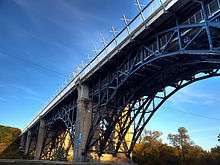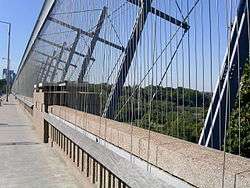Prince Edward Viaduct
| Prince Edward Viaduct | |
|---|---|
 | |
| Coordinates | 43°40′31″N 79°21′50″W / 43.67528°N 79.36389°WCoordinates: 43°40′31″N 79°21′50″W / 43.67528°N 79.36389°W |
| Carries |
Upper: 5 vehicle lanes and 2 bicycle lanes of Bloor Street East / Danforth Avenue Lower: 2 tracks of |
| Crosses | Don River |
| Locale | Toronto, Ontario, Canada |
| Other name(s) | Bloor Street Viaduct |
| Maintained by | Toronto Transportation Services, Toronto Transit Commission |
| Characteristics | |
| Design | Double-decked arch bridge |
| Total length | 494 metres (1,620 feet) |
| Clearance below | 40 metres (131 feet) |
| History | |
| Opened | October 18, 1918 [1] |
The Prince Edward Viaduct System, commonly referred to as the Bloor Viaduct, is the name of a truss arch bridge system in Toronto, Ontario, Canada, that connects Bloor Street East, on the west side of the system, with Danforth Avenue on the east. The system includes the Rosedale Valley phase (a smaller structure, referred to as the Rosedale Valley Bridge, carrying Bloor Street over the Rosedale Ravine) and the Sherbourne Phase, an embankment built to extend Bloor Street East to the Rosedale Ravine from Sherbourne Street. The Don Valley phase of the system, the most recognizable, spans the Don River Valley, crossing over (from west to east) the Bayview Avenue Extension, the Don River, and the Don Valley Parkway.
The roadway has five lanes (three eastbound and two westbound) with a bicycle lane in each direction.[2] The subway level connects Broadview Station in the east with Castle Frank and Sherbourne Stations to the west.
Design

Designed by Edmund W. Burke, the Prince Edward Viaduct is a three hinged concrete-steel arch bridge with a total span of 494 metres (1,620 feet), at 40 metres (131 feet) above the Don Valley. The bridge consists of a deck made of transverse beams and I-girders, which transfer load to column supports. The column supports then transfer the load to the trusses within the arches, which transfer the load to the arches themselves. Finally, the arches transfer their load through large hinges to a concrete pier and eventually to the ground. Steel was provided by Dominion Bridge Company.[3]
In addition to the Don River, the Don Valley Parkway, and Bayview Avenue, two railway lines, an electrical transmission line and a bicycle trail all pass under the bridge spans.
History

Referenda on the construction of the Prince Edward Viaduct were held in Toronto in every year from 1910 to 1913, with residents voting against its construction in 1912 by 59 votes and in favour in 1913 by 9236 votes.[4] The projected cost of its construction increased from CDN$759,000 in 1910 to CDN$2.5 million in 1913; its final cost was CDN$2,480,349.05 ($35.3 million in 2016 dollars[5]). Upon its completion in 1918, it was named for Prince Edward, Prince of Wales (later King Edward VIII).
The viaduct was designed to facilitate mass transit; its upper deck accommodated trams, while both the Don Valley phase and the Rosedale Valley phase included a lower deck for rail transport, controversial at the time because of its high additional cost. The bridge's designer and the commissioner of public works, R.C. Harris, were able to have their way and the lower deck eventually proved to save millions of dollars when the Toronto Transit Commission's Bloor–Danforth subway opened in 1966. The Rosedale Valley phase was not used for the subway, as the curve between each phase, as well as the curve to the west at Parliament Street, was considered too sharp for the subway. A separate bridge was built over Rosedale Valley, west of the Castle Frank Subway Station. This covered subway bridge was designed by John B. Parkin and Associates with De Leuw Cather Canada (now Delcan) and completed in 1966.
.jpg)
The Prince Edward Viaduct resulted in more rapid development of those portions of Toronto lying on the east side of the Don Valley.
Luminous Veil
Over time, the Prince Edward Viaduct became a magnet for suicide, falling bodies posing risk to the traffic underneath. With nearly 500 suicides by 2003, the viaduct ranked as the second most fatal standing structure in North America, after the Golden Gate Bridge in San Francisco.[6][7] At its peak in 1997, the suicide rate averaged one person every 22 days. In 1957, a child also climbed onto the railing and fell accidentally while walking along it.[8]
The suicides and safety risks prompted the construction of a barrier in 2003, though it was first approved by Toronto City Council in 1998 and delayed because of concerns about funding; during that time, the viaduct was the site of an estimated 48 to 60 suicides.[9][10][11] The council originally approved a C$2.5 million budget. However, the minimum bid for construction was C$5.5 million.[9] Council eventually endorsed a fundraising campaign to raise the remainder of the money.[12] Construction was completed in 2003 at the cost of $5.5 million, with $2.5 million coming from taxpayers.[12]
The barrier was called the Luminous Veil.[6] Designed by architect Dereck Revington and engineers at Halcrow Yolles and completed in 2003, the Luminous Veil consists of over 9,000 steel rods, 12.7 cm apart and 5 m high, stretched to cantilevered girders.[13] The tensile structure was difficult to analyze and required several tests at the University of Toronto. Initially, cost prohibited the planned lighting to be installed on the top horizontal member. The lighting installation was completed in July 2015.[14] The Luminous Veil received in 1999 a Canadian Architect Award of Excellence.[15]

A 2010 study found that though the barrier prevented suicide attempts from the Viaduct, overall rates of suicide by jumping for the city of Toronto have not changed since its construction.[16]
Appearance in popular culture
In film
In literature, plays, and publications
(Alphabetical by author)
In music
- "War on Drugs" by the Barenaked Ladies
- "Anything could happen" by Bruce Cockburn
- "National Hum" by The Constantines
In television
- Degrassi Junior High episode titled "Dog Days"
See also
References
- ↑ http://www.nrcresearchpress.com/doi/pdf/10.1139/l84-105
- ↑ Photo of westbound traffic
- ↑ http://spacing.ca/toronto/2010/04/09/building-storeys-the-canada-linseed-oil-mills-buildings-sorauren-park/
- ↑ "Toronto Prepares For A Million People, Carries All Bylaws, Bloor Street Viaduct Will Be Built". Toronto World. January 2, 1913. p. 1.
- ↑ Canadian inflation numbers based on Statistics Canada. "Consumer Price Index, historical summary". CANSIM, table (for fee) 326-0021 and Catalogue nos. 62-001-X, 62-010-X and 62-557-X. And Consumer Price Index, by province (monthly) (Canada) Last modified 2016-01-22. Retrieved March 2, 2016
- 1 2 Ritter, John (January 31, 2005). "Suicides tarnish the Golden Gate". usatoday30.usatoday.com. Tysons Corner, VA: Gannett. ISSN 0734-7456. Archived from the original on March 16, 2014. Retrieved March 16, 2014.
North America's No. 2 suicide draw, Toronto's Prince Edward Viaduct, built a multimillion-dollar barrier in 2003 after more than 400 suicides.
- ↑ Rivera, John (January 13, 2003). "A barrier to hopeless souls". The Baltimore Sun. Baltimore, Maryland: Tribune Company. p. 1. ISSN 1930-8965. Archived from the original on March 16, 2014. Retrieved March 16, 2014.
"We look at this bridge and know there are at least 480 souls at the bottom who spent the last moment of their life on the way down. This is where they spent their last day before they went to eternity" says Al Birney
- ↑ "Tumbles From Viaduct, Boy Hits Mud, Unhurt". Globe and Mail. June 3, 1957. p. 1.
- 1 2 Mental Health Promotion: Overcoming the challenges to 'focusing upstream'
- ↑ Do barriers around bridges prevent suicides?
- ↑ NOW: Where spirits live, May 8 - 14, 2003 Archived December 14, 2006, at the Wayback Machine.
- ↑ NOW: Where spirits live, May 8 - 14, 2003 Archived December 14, 2006, at the Wayback Machine.
- ↑ Bloor Viaduct’s ‘luminous veil’ to light up for Pan Am torch relay
- ↑ "Suicide prevention barrier". Canadian Architect. Business Information Group. August 2001. Archived from the original on October 22, 2006. Retrieved March 16, 2014.
- ↑ Bridge Barrier Fails to Lower Toronto's Suicide Rate: Suicide-by-jumping rate at Bloor Street Viaduct lower; rates at other bridges higher, HealthDay News, July 7, 2010. Retrieved from ModernMedicine.com's website, July 2, 2013.
External links
| Wikimedia Commons has media related to Prince Edward Viaduct. |